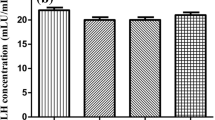Summary
Intensely refractile inclusions of lipoprotein were demonstrated within the cytoplasm of granulosa-luteal cells. These inclusions lay either isolated within vacuoles or were grouped. They contained amino acids with SH groups. In corpora lutea of pregnancy, either extrauterine or intrauterine, they were most abundant. In corpora lutea of menstruation they were sparse. The granulosa-luteal cells with the inclusions were evaluated histologically and histochemically for their functional activity that always proved high. From these results and from the early appearance of the inclusions in the corpora lutea of pregnancy, their possible connection with a nonsteroid hormonal secretion is discussed.
Zusammenfassung
Im Cytoplasma der Granulosa-Luteinzellen wurden stark lichtbrechende, isoliert in Vacuolen oder in Gruppen liegende Lipoproteideinschlüsse nachgewiesen, die Aminosäuren mit SH-Gruppen enthalten. Sie waren im CLG von frühen intrauterinen oder extrauterinen Schwangerschaften sehr reichlich, im CLM in geringerer Zahl vorhanden. Gleichzeitig wurden die Einschlüsse enthaltenden Granulosa-Luteinzellen histologisch und histochemisch auf ihren Funktionszustand untersucht, der stets hoch war. Auf Grund dieser Befunde und wegen des frühen Auftretens der Einschlüsse im CLG wird ihr möglicher Zusammenhang mit einer nichtsteroidalen endokrinen Sekretion diskutiert.
Similar content being viewed by others
Literatur
Abramson, D., Hurwitt, E., Lesnick, G.: Relaxin in human serum as a test for pregnancy. Surg. Gynec. Obstet.65, 335 (1937).
Adams, E. C., Hertig, A. T.: Studies on the human corpus luteum. II. Observations on the ultrastructure of luteal cells during pregnancy. J. Cell Biol.41, 716 (1969).
Albert, A., Money, W. L., Zarrow, M. X.: An improved method of extraction and purification of relaxin from fresh whole ovaries of the sow. Endocrinology40, 370 (1947).
Ask-Upmark, M. E.: Zit. nach Pedersen und Larsen (1968), Acta obstet. gynec. scand.5, 211 (1926).
Brandau, L., Luh, W.: Enzymologische Untersuchungen am Corpus luteum graviditatis des Menschen. Z. Geburtsh. Gynäk.162, 294, 304 (1964).
Carsten, P. M.: Elektronenmikroskopische Probleme bei Strukturdeutungen von Einschlußkörpern im menschlichen Corpus luteum. Arch. Gynäk.200, 552 (1965).
Dallenbach, F. D., Dallenbach-Hellweg, G.: Immunologische Untersuchungen zur Lokalisation des Relaxins in menschlicher Placenta und Decidua. Virchows Arch. path. Anat.337, 301 (1964).
Dallenbach-Hellweg, G., Nette, G.: Über Proteineinschlüsse in basalen Trophoblastzellen der reifen menschlichen Placenta. Virchows Arch. path. Anat.336, 528 (1963).
Diezel, P. B.: Histochemische Untersuchungen am Corpus luteum graviditatis. Verh. d. Dtsch. Ges. f. Path. 46. Tagg, S. 320 (1962).
Hardonk, M. J.: A new method for the histochemical demonstration of steroid producing cells in human tissues. Histochemie5, 234 (1965).
Hisaw, F. L., Zarrow, M. X.: Relaxin in the ovary of the domestic sow. Proc. Soc. exp. Biol. (N. Y.)69, 395 (1948).
Hoffmann, F., Lam, L.: Über die Progesteronbildung im Zyklus und in der Schwangerschaft. Zbl. Gynäk.70, 1177 (1948).
Jaeger, J., Dallenbach-Hellweg, G.: Elektronenmikroskopische Befunde an den endometrialen Körnchenzellen des Menschen. Gynaecologia (Basel)168, 117 (1969).
Miller, J. W.: Corpus luteum, Menstruation und Gravidität. Arch. Gynäk.101, 568 (1914).
Motlik, K., Krawczynski, K., Nowoslawski, A.: Experimental hyaline droplets in the rat adrenal cortex. Virchows Arch. Abt. A Path. Anat.344, 331 (1968).
Nelson, W. W., Greene, R. R.: Some observations on the histology of the human ovary during pregnancy. Amer. J. Obstet. Gynec.76, 66 (1958).
Pearse, A. G. E.: Histochemistry, theoretical and applied. London: J. and A. Churchill, Ltd. 1968.
Pedersen, P. H., Larsen, J. F.: The ultrastructure of the human granulosal lutein cell of the first trimester of gestation. Acta endocr. (Kbh.)58, 481 (1968).
Pfleiderer, A., Diezel, P. B.: Histochemische Untersuchungen der Fette und Lipoide im Gelbkörper. Frankfurt. Z. Path.70, 207 (1959).
Pommerenke, W. T.: Experimental ligamentous relaxation in the guinea pig pelvis. Amer. J. Obstet. Gynec.27, 708 (1934).
Rennels, E. G.: Observations on the ultrastructure of luteal cells from PMS und PMS-HCG treated immature rats. Endocrinology72, 373 (1966).
Romeis, B.: Mikroskopische Technik. München u. Wien: R. Oldenbourg 1968.
Sachs, H.: Quantitativ histochemische Untersuchungen an den Granulosaluteinzellen des menschlichen Ovars. Arch. Gynäk.205, 105 (1968).
Author information
Authors and Affiliations
Additional information
Mit Unterstützung der Deutschen Forschungsgemeinschaft.
Rights and permissions
About this article
Cite this article
Larraguibel, R., Dallenbach-Hellweg, G. Histochemische Untersuchungen zur Frage spezifischer Einschlüsse in den Granulosa-Luteinzellen des Corpus luteum graviditatis. Arch. Gynak. 208, 224–234 (1970). https://doi.org/10.1007/BF00666905
Received:
Issue Date:
DOI: https://doi.org/10.1007/BF00666905




